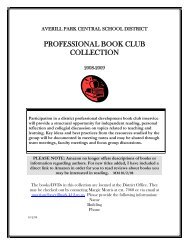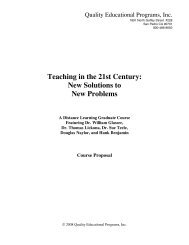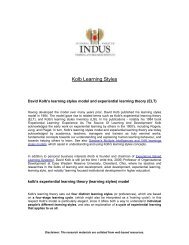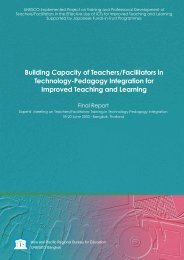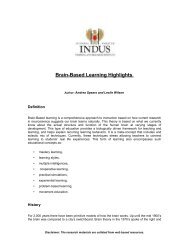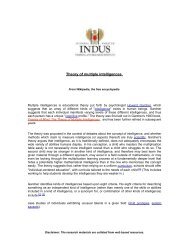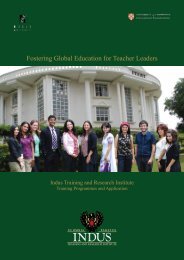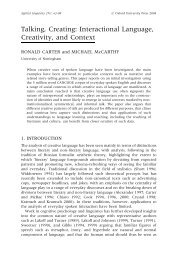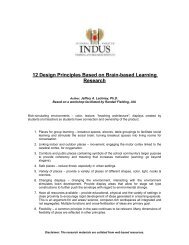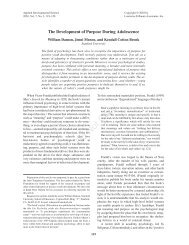Primary Years Programme Making the PYP happen - ITARI
Primary Years Programme Making the PYP happen - ITARI
Primary Years Programme Making the PYP happen - ITARI
- No tags were found...
You also want an ePaper? Increase the reach of your titles
YUMPU automatically turns print PDFs into web optimized ePapers that Google loves.
<strong>Making</strong> <strong>the</strong> <strong>PYP</strong> <strong>happen</strong><br />
How do I collect <strong>the</strong> data<br />
Observations:<br />
All students are observed often and regularly, with <strong>the</strong> teacher taking<br />
a focus varying from wide angle (for example focusing on <strong>the</strong> whole<br />
class) to close up (for example focusing on one student, or activity),<br />
and from non-participant (observing from without) to participant<br />
(observing from within).<br />
Performance assessments:<br />
Process-focused assessments:<br />
Selected responses:<br />
Open-ended tasks:<br />
Portfolios:<br />
The assessment of goal-directed tasks with established criteria. They<br />
are meaningful and significant challenges and problems. In <strong>the</strong>se<br />
tasks <strong>the</strong>re are numerous approaches to <strong>the</strong> problem and rarely only<br />
one correct response. They are usually multi-modal and require <strong>the</strong><br />
use of many skills. Audio, video and narrative records are often<br />
useful for this kind of assessment.<br />
All students are observed often and regularly and <strong>the</strong> observations<br />
are recorded by noting <strong>the</strong> typical as well as non-typical behaviours,<br />
collecting multiple observations to enhance reliability, and<br />
syn<strong>the</strong>sizing evidence from different contexts to increase validity. A<br />
system of note taking and record keeping is created that minimizes<br />
writing and recording time. Checklists, inventories and narrative<br />
descriptions are common methods of collecting observations.<br />
Single occasion, one-dimensional exercises. Tests and quizzes are <strong>the</strong><br />
most familiar examples of this form of assessment.<br />
Situations in which students are presented with a stimulus and asked<br />
to communicate an original response. The answer might be a brief<br />
written answer, a drawing, a diagram or a solution. The work, with<br />
<strong>the</strong> assessment criteria attached, could be included in a portfolio.<br />
A purposeful collection of a student’s work that is designed to<br />
demonstrate successes, growth, higher order thinking, creativity and<br />
reflection. Portfolios should not be thought of as a collection of work<br />
but ra<strong>the</strong>r as an exhibition of an active mind at work.<br />
How do I evaluate <strong>the</strong>se types of assessment<br />
Rubrics:<br />
An established set of criteria used for scoring or rating students’<br />
tests, portfolios or performances. The descriptors tell <strong>the</strong> assessor<br />
what characteristics or signs to look for in students’ work and <strong>the</strong>n<br />
how to rate that work on a predetermined scale. Rubrics can be<br />
developed by students as well as by teachers.<br />
Benchmarks:<br />
Holistic scoring:<br />
Analytical scoring:<br />
Samples of students’ work that serve as concrete standards against<br />
which o<strong>the</strong>r samples are judged. Generally <strong>the</strong>re is one benchmark<br />
for each achievement level in a scoring rubric.<br />
This produces a single score, typically based on a four to six point<br />
scale. It is based on <strong>the</strong> overall impression of a sample of work, rated<br />
against established criteria.<br />
This awards separate scores for different aspects of <strong>the</strong> work. This<br />
yields more information than holistic scoring and is often used for<br />
diagnostic purposes or when students need specific feedback on <strong>the</strong>ir<br />
strengths and weaknesses.<br />
90 © IBO 2000



